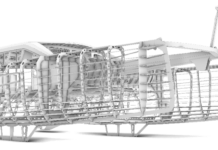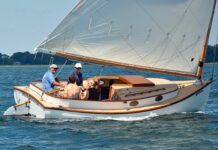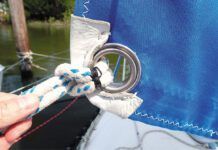Thanks, Dan
I read this months (April) edition before last months (March) to discover editor, now former editor, Dan Spurr has tossed in the pen for a front porch in Montana. He is right, though: the world is enormous and time vanishes like vapor. But as one whos benefited from Practical Sailors rigorous tests, I want to thank Dan and staff for their labors and wish he and his family fair winds whether lubbing the land or coursing the seas. And to new editor, Douglas Logan, thanks for picking up the pen on behalf of us who are now, or soon to be, dependent upon your uncompromising will to break things so we wont have to.
-Jim Dodge
Canby, OR
———-
Stereo Realities
Just finished reading all my backlog of Practical Sailor after returning to the states from the Rio Dulce in Guatemala. Prior to departure for the States I spent about ten very frustrating hours repairing a Jensen MIDC9645W marine stereo system for a fellow cruiser. Your review of that unit and its competitors(April 1, 2001) merits a few comments.
First of all the technology we are looking at is all pretty much derived from the auto stereo industry. I managed to check out about half of the units you reviewed and found all of those have an identical Achilles heel. These units do not really turn off. Instead they just go to sleep and keep power supplied to some of the circuitry such as the microprocessor and its associated memory through a seperate power feed. This allows retention of the stored settings and station frequencies for the am/fm side of the unit. This type of design can be a disaster in a boating environment, especially out here in the Third World.
This is especially true when vessels are tied up to the dock and are connected to the local power grid. That grid is usually very limited in size so that lightning hits are not attenuated the same way as a similar hit on a power grid in the States where there are tens of thousands of miles of wire to soak up a pulse. In the Third World the amount of wire out there may only be a few hundred miles at most. Spikes on the line are a virtual everyday occurence. That, combined with sometimes poor engineering practices at the generating facilities can cause the average dockside boater to experience huge variations in AC voltage accompanied by some extremely high voltage spikes. These spikes can ride right in through your battery charger and can put a spike on your 12-volt system that can exceed 100 volts. The Jensen unit I repaired experienced just such a hit. The switching transistors typically used in devices of this type are rated at 40 to 50 volts DC max. Any voltage above that and they are destroyed. This destruction also tends to burn out circuit traces as well. This was the case with the Jensen systemI had to repair. Disassembly and re-assembly of the Jensen is difficult… something on the order of working with a Rubics Cube. Since much of the unitutilizes surface mount technology, getting in there with a soldering iron to make repairs has a difficulty factor something akin to milking a mouse. All of these problems were evident in the unit I repaired. Finding someone out here to do this type of repair is almost impossible and the shipping and customs problems one experiences sending the unit back to manufacturer from a Third World country are almost insurmountable.
I caution everyone using this type of device to make sure they shut it down at the breaker panel and that BOTH power feeds are offline when the unit is not in use. I would suggest to the manufacturers that they either do a battery backup or use non-volatile memory to store the frequency and settings data required by the unit as opposed to keeping power on part of the circuitry all of the time. This way the unit can be truly off line when turned off. Performance of the Jensen was superb…unfortunately survivability and servicability werent.
My recommendation for long distance cruisers is to get a boombox style unit that is of size that will fit well in your boat. Units with detachable speakers are my choice. Extra speakers can be added as well for locations remote from the unit. These units are relatively easy to repair, give good performance and don’t hit the cruising budget quite as hard. In a stateside environment the Jensen unit would be an excellent choice if one doesn’t plan to go too far afield.
-Bob Hill
Rio Dulce River, Guatemala
———-
In 1997, I purchased an AM/FM/cassette unit from J.C. Whitney for $149.95(Less than $150!!!). It was designed for vans and came with a remotecontrol the size of a credit card. It also has an input plug for a Walkman-type CD-player. I mounted the unit high on a mid-boat bulkhead, safe from weather and galley splashes. The remote lives in a winch handle locker when sailing. I can control volume and turn the music on and off from the helm. If a cassette or CD finishes and I can’t get down to the cabin to change it, I can switch to radio. No weather channel, but with a VHF radio nearby, thats hardly an issue. With speakers in the cabin and in the cockpit, its been a satisfactory setup. Well see if the remote battery made it through its fourth winter of unheated storage, if it ever stops snowing on the shores of Lake Ontario.
-Peter Schermerhorn
Rochester, NY
———-
BVI Bareboat Experiences
I really enjoyed the article on bareboat charter companies in the BVIs (April 1, 2001). The information was very good and the tips were great. We determined the best way to pack is nearly nothing, shorts and bathing suits. We pick up T-shirts along the way at our mooring location; it augments the wardrobe and provides a nice memento of the trip.
My only comment is the tone of the article seems to discourage using the smaller charter firms. You are right, particularly so when the client(s) have little or no experience.
Assumption: The client has a bareboat certificate, some navigational experience and at least a couple of stateside charters under their belt.That being the case I would encourage price shopping. Keep an eye on the age of the vessel you intend to charter and use good judgment. By doing this those who are anxious to sail the BVIs can get some great bargains. If you hit upon a company that meets your needs, most give a discount for return clients, usually 10%, so you are really set for future trips.
I have had great success with Horizon Yacht Charters. They are a small company out of Nanny Cay on Tortola. Most of the boats are new, in fact the 37′ Baveria we chartered last December was recently arrived from France and brand new. We took her out on her maiden charter. We have a 42′ Catalina reserved for our return this coming December.
Thanks for your continued commitment to sailing and the sailing public.
-Mike Ryan
Concord, NC
———-
Thanks for your realistic profile of the industry, something long overduefrom the sailing press. The information presented by most of the othermagazines amounts to little more than a sales brochure, and doesn’t preparethe charterer (especially new charterers) for what theyre likely toexperience.
My wife and I and have been active charterers for many years, both here onthe West Coast and in the Caribbean. Based on our experiences I would certainly agree with the maxim that you get what you pay for, but Id also note that paying a premium is no guarantee of a trouble-free cruise. What it can help ensure, however, is that when a problem does occur the company has the people and resources to resolve the issue quickly.
An example can be found in some of the experiences weve had in the BVI. In97 we chartered a 40′ sloop with one of the first-tier companies. On our second day out we had a voltage regulator fail while moored at the RMS Rhone dive site off Salt Island, preventing us from starting the auxiliary. Via the on-board cell phone, one of the companys staff technicians walked me through a temporary wiring modification that got us underway. Their chaseboat met us at Cooper Island less than two hours later with the same fellow aboard, who then made a permanent repair. They even brought us a bag of ice, without our asking! It was quick, courteous service from an organization that had the resources in place to resolve our problem with a minimum of disruption to our trip.
Contrast this with the experience we had last October with a third-tier company. On day 3 of our trip we sailed to Anegada, 14 n.m. north of VirginGorda. The next morning we arose to discover that none of the boat electrics was working. The engine wouldnt even crank. On examination we found both the house and starting batteries reading less than 10 volts. We got out the tool kit and began some basic troubleshooting, only to find that the positive terminals of the house and starting batteries were strapped together! Using a cell phone brought by one of our guests we made contact with the charter office and explained our situation. They were courteous and appropriately concerned about the problems we were experiencing, but advised that they wouldnt be able to attempt repairs until the next day at the soonest -theyd have to hire a technician from Tortola and fly him out. We dingied the starting battery ashore where the hotel let us use the charger from their garage. We got ourselves underway that afternoon.
When the technician met up with us two days later at Cane Garden Bay, he found that while the engine was equipped with two alternators (one for each battery bank), only one was working. He theorized that when the first alternator had failed someone made a temporary fix by connecting the two banks, allowing both batteries to charge from the remaining working alternator.When we started the batteries had a fresh shore side charge, but the single alternator couldnt keep them charged while underway.
Once repairs were complete the rest of our cruise was uneventful. When the charter company learned what we had found they seemed mystified as to how the boat had gotten into such a condition.They were also eager to make it right, which they did through monetary consideration offered at the end of our cruise.
Bottom line-if you charter, bear in mind that boats break no matter how much you pay. Also be aware that the discount companies may not have the means to maintain the boats appropriately or respond quickly when theres aproblem. Dont let the potential downside prevent you from chartering, but go with realistic expectations.
-Bill Sikich
Seattle, WA
———-
We charteredfrom Horizon Yacht Charters in Nanny Cay, Tortola.Being the busy PresidentsWeek, all the other charter companies were booked. We all agreed it was the best chartering experience we have ever had. Since Horizon was a company we never heard of (BoatUS found the company for us) I suppose that would put them in the category of a third-tier company, but I feel so positive about our experience that I am writing in the hopes that you will give honorable mention to this company.
-Ernest Wasserman
Brooklyn, NY
———-
This year we charted from Trade Winds which was cheaper than Footloose and we liked it the best of all the charter companies we have used. If you book your flight through them you sleep the first night at the dock free on the boat, which is important for us since we came from Los Angeles on the Red Eye.
I feel youve done your readers a disservice by not doing more research on the charter companies and even why the island is so popular for sailing. I realize that other magazines might be competition for you but we have always found the charter companies fromother sailing magazines, particularly Sail.
-Roger Marshutz
Los Angeles, CA
———-
Compass Fluid
Most aircraft compasses use jet fuel to fill the unit. This is an ultra pure and crystal clear form of kerosene (mineral spirits). At least one marine compass I worked on also used this fluid so I presume most compasses use the same thing. It is available at most airports. Clear lamp oil might be just as good if more convenient.
-Jim Buzbee
Mineral Wells, TX
———-
Sunglasses
I read your review of sunglasses in the Number 9/10 online edition. Twoyears ago, I purchased a pair of Serengeti H2Optix sunglasses (theLaguna style). Like you, I found the Serengetis to be comfortable andto provide very clear vision, particularly for mid-priced glasses. Ialso was looking for durability and believed that their flexible frameswould prevent the glasses from breaking. As it turned out, I was verymistaken on this latter point. After one year of use, the earpiecebroke at the hole that permits the neck strap to be clipped to theframes. Shortly thereafter, the cushioned insert in the earpiece cameout, and the thin portion of the frame that had surrounded the cushionedinsert also broke, leaving a very sharp, jagged edge. The coup de gracecame when my 18-month-old son pulled the glasses off my face a few weeks ago and snapped the part of the frame surrounding one of the lenses.Into the garbage they went. (In true sailor fashion, I tried to fixthem with epoxy, but it did not adhere very well to the frame.) Needless to say, I am very disappointed in the lack of durability in these frames, particularly because I otherwise liked these sunglasses very much. I am, once again, in the market for a pair of sunglasses. This time around, though, Serengetis are definitely off my list.
There are two pairs of sunglasses that Harken manufactures, and I was very surprised that you did not include those sunglasses in your review, particularly because they are specifically manufactured for and marketed to sailors. If you have any experience with them, I would be very interested to know how you rate them.
-Doug Poland
Chicago, IL
———-
Pacific Seacraft
I own a 1987 Pacific Seacraft 34 andcannot say enough good things about it. Ive had it 13 years and plan to keep it for at least another 13.This is my retirement, sailaway boat. Although I bought the boat when it was a year old, Pacific Seacraft has always treated me as a new customer. My initial survey turned up three small deck voids. Pacific Seacraft reimbursed me for the repair costs. The factory, in particular Robin Bradshaw, have always been most responsive to requests for assistance. They are extremely proud of their yachts, as well they should be.
By the way, the pictures that you have in your article for the 37 are actually pictures of the 34.
Great writeup for great boats.
-John Payton
Weymouth, MA
Editors note: Thanks to Mr. Payton and several others who didnt miss our stupid layout error, as we did in our proofreading. Editors, forsooth. See this month’s Riprap, page 35, for drawings of the Pacific Seacraft 37.
———-
Where Credit Is Due
To Tops-In-Quality, Marysville, MI: I ordered a custom midships boarding ladder for my center cockpit Tayana 42 right after the 1999 Sailboat show in Annapolis, MD from Tops-In-Quality. The order form was fairly straightforward and after making the required measurements and several telephone conversations I thought that everything was on-track. Several weeks later the ladder arrived (it is truly a beautiful piece of manufacturing work) and I mounted it to the boat. My wife immediately commented on how the ladder interfered with deck passage while stowed (I mentioned something about how nothing can ever be perfect on a boat).We used the ladder for the season and found that its intrusiveness was a problem. I contacted Tom at Tops-in-Quality, he said to mark the ladder where it needed modification and send it back. A few weeks later the ladder returned, modified exactly as needed at no cost, not even postage! We had used the ladder for almost a year before returning it for modifications! How many companies would do that?
-Mark Eller
Solomons, MD
To Tartan Yachts et al: The pleasant experience and excellent service provided by Tartan Yachts and their Seattle dealer, Alliance Yacht Sales, has made us better understand the rewards of a new boat purchase. As with any complex creation, a new boat needs modifications, fixes, and adjustments. Our new Tartan 3700 was no exception. As we worked through the punch list, there was never a hesitation on the part of the Tartan and Alliance sales teams to make everything perfect. With the superb work of Sound Rigging and Yacht Services of Seattle, they tweaked everything we asked for, and at no additional cost to us. Our experience with Tartan and Alliance has shown that a quality manufacturer and reputable dealer can result in a terrific experience when buying a new boat.
-Richard Harding and Kanita Hills
Santa Fe, NM






































